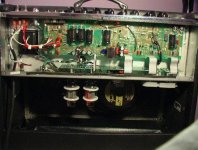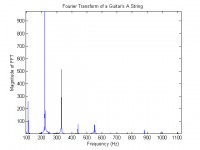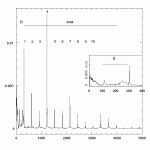A void can open any time, though that is a lot less common that say a loose joint.
SO get behind the baffle board, and run a steady signal at the buzz frequency, and press forward with your spread fingers. Stops the buzz?
I don't recall, does the baffle on the HR series float in a groove or is it screwed in place?
Oh, looks like six screws three across the top and three bottom. Any loose? Pull the baffle board and hold it up off the cab, run the signal, does it still buzz?
Take a rubber mallet to the cab walls, does hitting it anywhere cause a crack or flap sound - anything other than rubber on wood?
With the baffle removed, grip the top of the amp, the handle should do I suppose. Try wiggling it side to side, does the cab flex at all? Looking for corner joints not tight.
SO get behind the baffle board, and run a steady signal at the buzz frequency, and press forward with your spread fingers. Stops the buzz?
I don't recall, does the baffle on the HR series float in a groove or is it screwed in place?
Oh, looks like six screws three across the top and three bottom. Any loose? Pull the baffle board and hold it up off the cab, run the signal, does it still buzz?
Take a rubber mallet to the cab walls, does hitting it anywhere cause a crack or flap sound - anything other than rubber on wood?
With the baffle removed, grip the top of the amp, the handle should do I suppose. Try wiggling it side to side, does the cab flex at all? Looking for corner joints not tight.
Update!!!!!!!!!
I don't want to hijack this thread so I may start a new one.
It turns out it is the speaker. The test speaker I used before was the same exact model speaker and made the same noise at the same frequency but to a much lesser degree. I can't tell if it's the paper cone or something in the voice coil area. Is this something that's fixable or should I just order a replacement speaker?
I find it strange both speakers have the same issue but they are the same model. When I play an 82Hz sine wave through the amp it doesn't do it. When I pluck a low E note on any of my guitars it does it, I have tried 4 guitars all with same effect. I am wondering if I should hook the amp up to a scope and look at the signal while plucking the string? Maybe some sort of oscillation causing the speaker to make the noise?
Here is a video of the nosie: https://youtu.be/7LabaK8fwvs
I don't want to hijack this thread so I may start a new one.
It turns out it is the speaker. The test speaker I used before was the same exact model speaker and made the same noise at the same frequency but to a much lesser degree. I can't tell if it's the paper cone or something in the voice coil area. Is this something that's fixable or should I just order a replacement speaker?
I find it strange both speakers have the same issue but they are the same model. When I play an 82Hz sine wave through the amp it doesn't do it. When I pluck a low E note on any of my guitars it does it, I have tried 4 guitars all with same effect. I am wondering if I should hook the amp up to a scope and look at the signal while plucking the string? Maybe some sort of oscillation causing the speaker to make the noise?
Here is a video of the nosie: https://youtu.be/7LabaK8fwvs
That's probably because there's very little fundamental frequency energy in a typical picked guitar note. Try around 165 Hz, or around 247 Hz - my guess is you'll find the rattle near one of those frequencies.FamousMockingBird said:When I play an 82Hz sine wave through the amp it doesn't do it. When I pluck a low E note on any of my guitars it does it
Dotneck, unfortunately, the human eye is not capable of performing Fourier transforms simply by looking at a waveform. It would have been a very useful ability for audio enthusiasts, amp techs, and musicians to have, but evolution was not so kind as to give it to us.it seems to show that the largest part of the signal is INDEED THE FUNDAMENTAL and not the harmonics as has been posted elsewhere.
Since eyeballs are useless for this task, let's take a look at an actual measurement or two. Firstly, recall that a guitar in standard tuning has its open low "A" (5th string) tuned to 110 Hz.
Now take a look at the first attached image, which shows the Fourier transform of a guitar's picked open "A" string.
Where is the tallest peak on the attached spectrum image? Not at 110 Hz. Instead, it's at 220 Hz!That's the 2nd harmonic, and not the fundamental.
And where is the second-tallest peak of the spectrum? At 330 Hz, i.e., the 3rd harmonic. Even the 3rd harmonic is often stronger than the fundamental frequency when it comes to guitars!
You can alter this spectrum to some degree by, for example, picking with the soft flesh of the fingertip, and picking right over the 12th fret. This mid-point string location, and the soft fingertip flesh, will substantially boost the fundamental frequency, and reduce the strength of the harmonics.
More generally, the spectrum will vary with picking location, picking force, hardness of pick, sharpness or bluntness of the pick's point, et cetera. But normal playing techniques result in the fundamental being weaker than some of the harmonics.
To demonstrate this point once again, take a look at the second image. This is a high "E" string, tuned to 329.63 Hz in standard tuning. Yet the tallest peak in the spectrum is a little higher than 1200 Hz - that's the fourth harmonic!
(String stiffness, air resistance, pickup magnet pull, all detune the high harmonics of guitar strings a little, which may be why this peak isn't exactly at the expected 1318.5 Hz.)
In an earlier post you suggested that a bass guitar's highest fundamental frequency was 330 Hz, and that this was as high as a bass guitar amp needed to go. I would suggest we go with 392 Hz, which is G4, the 24th fret on the G string of 4-string bass in standard tuning. Most basses except for ancient "classic" designs now have 24 frets; both my Yamaha basses, for example, have 24 frets, though my Squier 5-string Jazz Bass does not.
We can now see that we should allow for at least the 4th harmonic to be accurately reproduced, which, for a 4-string bass in standard tuning, takes us up all the way to 1.568 kHz.
For "classic" bass playing techniques, this is probably a realistic, but conservative, upper cut-off frequency that our bass guitar amp must meet, at a minimum. For popping, slapping, harmonics, and various other more modern playing techniques, we should be looking at 5kHz at a minimum. (Hence all those tweeters and even some aluminum speaker cones in bass guitar amps.)
Links:
1) Frequencies of musical notes: Frequencies of Musical Notes, A4 = 440 Hz
2) Source for plucked A-string spectrum: Another way of viewing the world
3) Source for plucked high-E spectrum: Guitar Pluck
(UBC is the University of British Columbia, by the way. Full of very smart, very educated people, rigorously trained in the scientific method, like all good universities.)
-Gnobuddy
Attachments
With a sine wave input, an FFT should show any distortion from the amp. It would be interesting, for sure, but I'm not sure if it would help find the rattle?I can shoot a sine wave through and do a FFT plot and post it.
The two spectra I posted are of picked guitar strings, which are not very sine-like. Particularly at, and near, the beginning of the note, when there is a big starting transient full of high frequencies.
Jeff Beck knows this - when he eliminates that initial note attack with his pinkie-on-the-volume-knob swells, he can make his guitar sound like a foghorn, or a lonely whale, or a siren - anything but a guitar!
-Gnobuddy
It is without a question the speaker making terrible noises. I got around to playing the amp through a Jensen Speaker it sounded good. I played one of my home brew amps through the HRD stock Eminence speaker and the speaker makes the noise. It sounds like it's coming from the voice coil, it's not the basket or the wire leads coming from the coil.
The amp is mainly used for Jazz. I am thinking of going with the Weber California Ceramic. Any other suggestions for a good 12" Jazz speaker?
The amp is mainly used for Jazz. I am thinking of going with the Weber California Ceramic. Any other suggestions for a good 12" Jazz speaker?
Have you pulled the speaker yet? Make sure nothing has gotten in behind the cone in the frame, guitar picks find their way in there all the time. Loose screws or nuts can fall in there. Hold it cone facing up and shake to free anything caught in the frame.
Crap can get behind the grille cloth and lay against the cone, check that. Hold it cone down over your face and shake, hear anything rolling around inside the dust dome? A little bit of lacquer from the voice coil could have broken free.
Crap can get behind the grille cloth and lay against the cone, check that. Hold it cone down over your face and shake, hear anything rolling around inside the dust dome? A little bit of lacquer from the voice coil could have broken free.
Hi, Mabe it's not the case but I still like to tell you this story.
I had a vox with 2 jensen speakers.
The amp made odd sounds when played hard. Clean at low volumes.
It whas just out of warranty.
After a long search I finally had a look atthe speakers.
I noticed that the magnets moved a bit.
After removal it appeared that the magnets came loose on both speakers.
Replacing the speakers resolved the problem.
Try to pull at the magnet of the speaker and look if it's moving...
I had a vox with 2 jensen speakers.
The amp made odd sounds when played hard. Clean at low volumes.
It whas just out of warranty.
After a long search I finally had a look atthe speakers.
I noticed that the magnets moved a bit.
After removal it appeared that the magnets came loose on both speakers.
Replacing the speakers resolved the problem.
Try to pull at the magnet of the speaker and look if it's moving...
It is without a question the speaker. I tried to see if anything was loose but the noise is coming from inside the voice coil where I can't get to. When I sweep signals through it I can get it to actually make the noise at lower amplitudes and there is noway to look inside there without ripping the dustcap off.
So the speaker is a goner? OK, what is there to lose? Carefully use a sharp Xacto blade or razor blade and cut the dust dome off. MAybe something will shake out, then glue the dome back on or get a new done and glue it in place. If it doesn't expose a correctable problem, well the speaker was a goner anyway.
- Status
- This old topic is closed. If you want to reopen this topic, contact a moderator using the "Report Post" button.
- Home
- Live Sound
- Instruments and Amps
- Fender Hot Rod Deluxe - Some strange symptoms..


